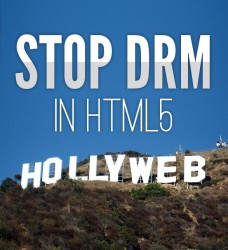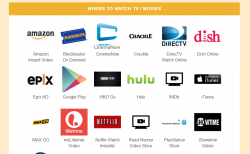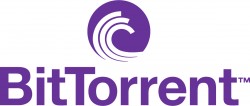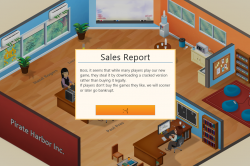You’d think that with their swarms of PR people, Nintendo and Microsoft (and previously, Sony) could have managed this week better (and Sony previously with their so called PS4 launch). Maybe it’s just me, but there seems to be an air of desperation surrounding the major players in the gaming industry. Everyone’s in a rush to launch something, anything, or they’ve become overprotective of their assets. Perhaps signs of an industry struggling with the quickly changing landscape?
As you’ve guessed, this edition of the WNR is fairly gaming oriented for obvious (and not so obvious) reasons. Let’s get started …
 Dick f***in’ move. That’s how someone on Twitter described Nintendo’s copyright craziness this week, when the troubled gaming company decided it would be a great PR move to start claiming copyright on any Let’s Play gameplay videos featuring games owned by the company.
Dick f***in’ move. That’s how someone on Twitter described Nintendo’s copyright craziness this week, when the troubled gaming company decided it would be a great PR move to start claiming copyright on any Let’s Play gameplay videos featuring games owned by the company.
Let’s Play (LP) videos are very popular with the gaming crowd, and creators of these videos have so far received the support of gaming companies, or at the very least, no resistance. But Nintendo’s copyright move will now force ads to be displayed on any LP videos featuring footage of Nintendo games, and also gives the company the power to block videos it deems unacceptable.
It’s unlikely that the Japanese company will do the latter, unless it wants to face the wrath of the Internet, but doing the former also disadvantages LP creators by taking away the small amount of revenue that allows new videos to be continually created. For Nintendo, the revenue earned from these videos will be of little consequence, especially if the Wii U’s losing run continues.
So while Nintendo is justified in submitting a copyright claim, doing so seems to bring no benefits, and a lot of long term pain for a company that is desperate to get the word out on its new console. LP videos are great promotional tools, and Nintendo should be doing everything they can do ensure people continue to create videos for their games, but this move does the opposite of this.
From being oversensitive about copyright to being not sensitive enough. Or at least that’s what the RIAA is accusing Google of, as it wants the search engine giant to do more to stop infringing links showing up in search results, despite 20 million links already being removed so far.
Despite Google’s best efforts in making the DMCA takedown process as streamlined as possible, often at the expense of accuracy and due process, the RIAA says that Google should do more to make the process even simpler. Apparently, for every link removed via a takedown notice, many more will spring up in its place. It’s something that the RIAA has only now realised, although they could have asked me, or any of the other millions of people who knew this was always going happen, before their costly exercise in futility.
If beating a dead horse is not bringing results, there’s only one solution: beat it harder! Which is why the RIAA plans to use the currently ongoing Congressional review of the DMCA to lobby for changes to the DMCA takedown process. Under the RIAA’s fantasy version of the DMCA, they would only need to identify the content that is being infringed (eg. Mirrors by Justin Timberlake), the site that is doing the infringing (eg. downloadmp3sfree4all.com), and then it would be up to Google to patrol and investigate all links on the site and remove links automatically. So instead of submitting a takedown request, getting the link removed, and then for the same site to put up the same link on a different URL, and the whole process repeating itself, the RIAA would make Google do most of the hard work. And taking this a step further, the RIAA may not even have to tell Google which site is doing the infringing, after all, Google knows more about individual websites than the RIAA ever will. Hell, Google probably already knows which songs are being searched for, and who owns the rights to it, so why not just have Google become the RIAA’s copyright police?
Yes, it’s time consuming for rightsholders to identify infringing content and request action, but it’s hard for a very good reason: to prevent abuses of the process and prevent false positives. Only the rightsholder can tell whether something belongs to them or not, and not taking shortcuts prevents stupid and damaging things from happening. If anything, too many shortcuts are already being taken by rightsholders.
And even if you can invent a better, automated takedown system, don’t bet against innovative webmasters finding a way to automate the process of creating new links. It will still be an exercise in futility, just with higher volume of links being involved. At some point, one has to accept that preventing infringing content from appearing on the web, and preventing people from getting to them, is futile. The best and only solution is to do something to make people less interested in wanting to get them, by providing legal alternatives that render piracy pointless.
![]()
The big gaming news of the week was of course Microsoft’s unveil of the Xbox One console. I won’t bore you with the full details, which you can read here, but it’s probably worth taking a bit of time to talk about the less sexy, and the far more controversial aspects of the console: the “always-on” DRM and digital licenses.
Before we get to that, as a summary of the information so far, it appears that Sony’s console will be the more powerful console yet again, on paper. The Xbox One’s slower memory is offset by the inclusion of ESRAM, but the cost of this more complex architecture means that the Xbox One has to make do with a slower GPU. Sony gambled on the availability of cheaper GDDR5 memory, and they won, allowing more bucks to be spent on beefing up the GPU. Whether this will actually translate to better looking games on the PS4 is debatable. It will be up to how easy Sony will make it for developers to take advantage of the PS4’s hardware superiority, and whether developers will bother doing so. But based on the PS3 vs Xbox 360 examples, don’t expect night and day differences, if any (if anything, it’s probably easier to build for the slower system, which automatically ensures it will work fine on the faster system, as opposed to building for the faster system and having to downscale to the slower one – lowest common denominator).
The Xbox One’s HDMI pass-through is also interesting, even if it seems like a bit of an outdated way to do things. Apparently, you’ll be able to plug in your set top box to the Xbox One and it will overlay some kind of interface for it, with the IR blaster and HDMI-CEC working in conjunction to give you the impression that your Xbox One console is controlling your STB. An interesting concept if Kinect can be integrated to allow you to gesture/voice control non Kinect devices. It’s a transparent attempt by Microsoft to make the Xbox One the hub of your home entertainment, but those with receivers, or here in Australia where most TV viewing is done without a set top box, won’t find the function too useful. And for some reason, the whole pass-through thing reminds me of the RF modulator on the NES.
And now back to the less sexy.
First up, always-on DRM isn’t a requirement for the console, well not strictly speaking anyway. You don’t need a constant Internet connection to play offline games, or rather, the decision could be left up to the game publisher. This is because Microsoft will allow developers to tap into the power of their Azure cloud platform, and this could, for example, offload certain parts of the game’s processing to the cloud. This could then force games, even offline ones, to be only playable with an Internet connection, much like how EA/Maxis justified the “always-on” DRM for SimCity.
But the key point is that this will be completely optional, and whether this type of cloud gaming is even possible given the current state of the integration is questionable. Microsoft was keen to point out that even they don’t really have a clear idea how Azure can and will be used by game developers at this time. Let’s put this down to one to worry about in the future.
As for the actual DRM for games, there’s a whole lot of confusion about how it will work, because it will be different to what it is right now. Instead of licenses being attached to discs like currently, licenses will be digital in nature. Let me explain.
While games will come on Blu-ray discs, the disc themselves serve only as a delivery platform for the game content – the actual activation of the game will be done via your Xbox Live account, and game purchases will be tied to your Live account. So discs will no longer be used for authentication purposes, and once you install and activate your game, you can chuck the discs away (you can re-download the game any time from Microsoft). Think Steam games that come on discs, and you’re basically there.
So what happens when you want to take your game to your friend’s house? Right now, you just bring the disc and play. But with the Xbox One, you’ll have to bring the disc (to install the game, unless your friend has a super fast Internet connection that can download it really quickly), and log into your Xbox Live account to play the game (since the game is tied to your Xbox Live account). Again, think Steam and how you would play the game on a new computer – you’ll have to log into your Steam account first. If your friend wants to play the game using his or her account, then they’ll have to re-buy the game.
Offline play without online authentication, just like Steam, should also be possible. But it may be only for a limited time, with a re-connection/re-authentication required every 24 hours or something.
But what about trading and selling your old games? Steam won’t allow you to do it, but Microsoft do plan to implement some kind of system to allow digital games to be sold and traded, a system where they also take a cut of the transaction no doubt.
So Microsoft is definitely taking a different approach to game authentication. Sony has only said that they will not block used games, which is open to interpretation (since technically, the Xbox One doesn’t “block” used games either). From what we know so far, this puts a tick in the win column for the PS4 for those, like me, that hates DRM. But you know game publishers will just love Microsoft’s new system, especially if they get a cut of game sales/trades too. Whether that love translates into more exclusive content and features remains to be seen, but that’s probably Microsoft’s endgame.
Looking at the three “next-gen” consoles and the launches, I have to say that all three have been fairly disappointing. My opinion is still that the Wii U is too little, too late (is it really that much better than the Xbox 360 or the PS3? It’s different, but that doesn’t mean better. I’m not even sure you can call it “next-gen”). Sony’s “PS4 launch without a PS4” was a joke really, and Microsoft’s Xbox One launch where they had all the answers except to the questions that people were actually most concerned about, makes both launches look amateur and rushed.
Why couldn’t Sony have shown us what the PS4 looked like at their launch? Why couldn’t Microsoft have waited until they’ve got all their DRM/used game trading/resell ducks lined up in a row before their launch, as opposed to the more and more cryptic answers to these fairly simple question? What couldn’t Nintendo produce a console that isn’t using a GPU based on a 4-year old design?
It’s a good thing though that E3 is only a couple of weeks away, but if Sony can’t reveal what a PS4 looks like by then, or if Microsoft can’t show us how game trading and resale actually works, then it’s just stupid and counterproductive.
But before then, tell us what you think of the three “next-gen” consoles in this poll, based on the information available so far.
An update to a story we covered here a couple of weeks ago. Despite heavy piracy and its unique DRM, the game Game Dev Tycoon has been successful enough for its developers for them to turn professional. Looks like their DRM stunt paid off, and to me, this actually proves that piracy can be leveraged to take advantage of its promotional qualities.
That’s pretty much it for this week’s gaming dominated issue. I will now log onto Netflix and impatiently wait until the (Pacific Time) clock strikes midnight to get my Arrested Development fix. See you next week.













